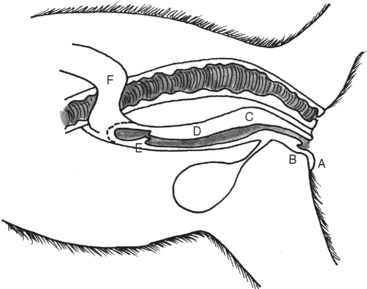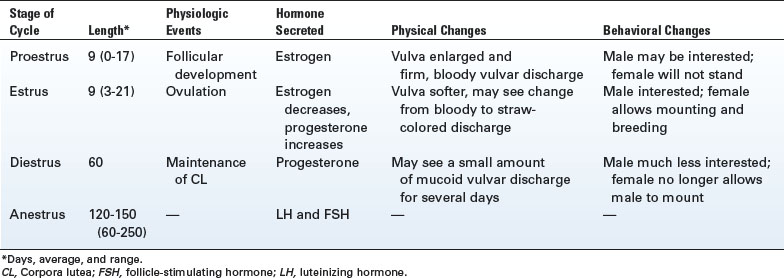8 Anatomy and Reproductive Physiology
I. EMBRYOLOGY AND ANATOMY OF THE FEMALE REPRODUCTIVE TRACT
Determination of gender depends on the sex chromosomes present in the embryo. All dogs have 78 chromosomes. Two of these are sex chromosomes; in females both are X chromosomes, and in males there is one X and one Y chromosome. In the absence of a Y chromosome, females develop ovaries (see Chapter 7). The female ductal system, the paramesonephric or müllerian ducts, develop to form the paired uterine tubes and uterine horns and fuse to form the uterine body and cranial vagina. The caudal vagina forms from a different embryologic tissue, the urogenital sinus. These two types of tissue fuse just cranial to the opening of the urinary tract into the vaginal vault (Figure 8-1). The clitoris forms from the genital tubercle, and the vulvar lips form from the genital swellings.
The cervix connects the uterus to the vagina and acts as a functional barrier between the two. The cervix is closed, preventing movement of anything between the vagina and uterus except during the heat cycle, at the time of whelping, and for about 3 weeks after the bitch has given birth. The cervix lies on the ceiling of the cranial vagina. Even when it is open, as evidenced by movement of uterine fluid through the cervix to drain through the vagina, it is not visibly open. The cervical canal does not lie parallel to the vaginal vault, making it difficult to pass instruments through the cervix.
II. PUBERTY
Puberty is defined as the onset of fertility; the first estrous, or heat, cycle, signals the onset of puberty. Bitches are considered to have gone through puberty when they have completed one fertile estrous cycle and have exhibited normal breeding behavior during that cycle. Age at attainment of puberty varies by breed. Small-breed dogs enter puberty earlier than large- or giant-breed dogs. Average age for onset of puberty is 6 to 10 months. Age at puberty onset may vary within lines of dogs as well. Technically a dog is not considered to have unusually late puberty onset unless she has not had a visible estrous cycle by 2 years of age. Abnormalities of puberty onset are discussed under Infertility (Chapter 19).
III. ESTROUS CYCLE
Bitches cycle, on average, every 7 months. Domesticated bitches are not seasonal breeders, with only one domesticated breed (Basenji) and wild dog or wolf crosses showing seasonality. Some breeds cycle much more frequently than the average; these include the rottweiler and German shepherd dog. Bitches continue to cycle throughout their life, although the length of time between heat cycles may increase with advanced age. Most bitches cycle fairly consistently throughout their life, although some bitches with normal fertility have great variability in the time between estrous cycles during their life. Various factors are involved in the onset of proestrus in bitches (Table 8-1).
Table 8-1 Factors Influencing Cyclicity in Bitches
| Factor | Influence on Cyclicity |
|---|---|
| Age | Puberty onset may be delayed in large- and giant-breed dogs or in some lines of dogs. Bitches technically are not abnormal unless they have not cycled by 2 yr of age. Advanced age may be associated with less frequent cycling in some bitches. Bitches do not go through menopause but continue to cycle, with reduced fertility, throughout life. |
| Whelping | Studies differ as to whether or not the interval to the next proestrus is longer in bitches that have whelped and nursed pups than in bitches that have undergone a nonpregnant diestrus. |
| Health | The primary hormonal disorder associated with abnormal cycling is hypothyroidism (see Chapter 6). Systemic disease conditions may cause abnormal cycling; reproduction is a luxury and severely ill animals will not cycle. Some bitches do not have a normal chromosome complement (78, XX), or they may have abnormal development of the reproductive tract. |
| Housing | Bitches housed with other cycling bitches are likely to be brought into proestrus by those bitches (“dormitory effect”). This probably is due to pheromone production by the cycling bitches. |
| Level of activity or use | Heavily worked or shown bitches or those stressed by their environment may be less likely to cycle. |
| Hormone therapy | Bitches treated with drugs to suppress heat may later have abnormal estrous cycles (see Chapter 11). Dogs treated with thyroid hormone inappropriately also may show abnormalities of cycling, especially after the drug is withdrawn (see Chapter 6). |
| “Silent heat” | Some bitches go through all the ovarian changes of a normal estrous cycle but show minimal outward signs. This is termed a “silent heat.” Bitches may show silent heat at one cycle and have a normal cycle the next time, or they may always show such minimal outward signs of estrus as to be classified as always having silent heats. Bitches with silent heat are fertile but may be difficult to get pregnant. |
| “Split heat” | Split heat is defined as an apparent normal heat cycle, evidenced by the physical and behavioral changes described above, that stops short without the bitch ovulating and is then continued, with a normal fertile ovulation, about 1 month later. Bitches may throw split heats sporadically between normal heats. They can be successfully bred on the second half of a split heat. |
The stages of the estrous cycle are differentiated by the physiologic events, physical changes in the bitch, and behavior of the bitch and dog during those stages (Table 8-2). Other changes, such as changes in vaginal cytology and other parameters that are used diagnostically, are described in Chapter 9.
< div class='tao-gold-member'>
Stay updated, free articles. Join our Telegram channel

Full access? Get Clinical Tree




